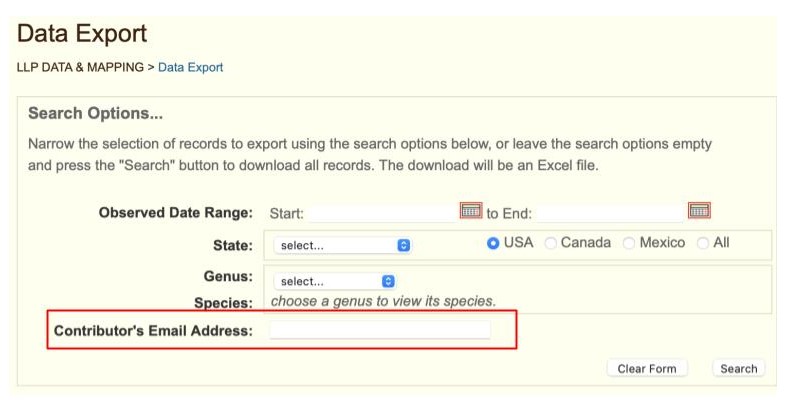Standards + Practices

Science Standards:
LS.5.2.1 Compare the characteristics of several common ecosystems ( including estuaries and salt marshes, oceans, lakes and ponds, forests, and grasslands) in terms of their ability to support a variety of populations.
LS.5.2.3 Use models to infer the effects that may result from the interconnected relationships of plants and animals to their ecosystem.
Science Practices
SP4: Analyzing and interpreting data
SP8: Obtaining, evaluating, and communicating information
Resources + Supports

Continuing to Search
Repeated searches, even when nothing is found, are important for data collection in Citizen science projects. Searching during the same or different weather, locations, and vegetation provides the opportunity for students to not only collect valuable data, but to also gain a deeper understanding of their schoolyards and patterns in their data. This is valuable information not only for the Lost Ladybug Project, but for comparing with a another location’s data as well.
Which species have your students found so far? Are the patterns you see at your school similar or different than the ladybugs found at other locations? This month, you’ll start to look at how your school’s findings relate to other locations, which helps address the second overarching scientific question. Now that students are beginning to make sense of data from other locations in the state, revisit their predictions related to the question about geographic variance.

Mr. Jones Prepares Data File for Class Use
Mr. Jones entered his email address on the data export page on the LLP website to generate a data file for students’ use. He repeated the process using the state feature to identify other locations with data collection in his state.

Looking at the file, he is concerned that the export as-is may be challenging for students to interpret. Before sharing the file with students, he decides to modify it in the following ways to make the file more student-friendly.
- Selecting a single user/location and filtering out submissions from other people so students are accessing multiple submissions by the same user.
- Hiding columns that students aren’t likely to use (e.g., submission ID, altitude): With columns hidden, students can focus on more pertinent pieces of the dataset (e.g., city, habitat, weather, time of day).
For more information on working with Google Sheets, including hiding columns, check out the Google Sheets cheat sheet.
- Sorting the entries by date submitted: With the entries sorted by the date they were submitted, students can more easily look for patterns over time.
- Setting up filters so that students can narrow the data set in different ways based on the factor they’re examining. For example, Mr. Jones wants his students to compare the habitats where ladybugs have been found in different locations, so he sets up a filter on the “habitat” column. With the filter set, students will be able to select particular habitats and view only entries of ladybugs found in those specified habitats.

Practice Overview: Analyzing and Interpreting Data
Analyzing and interpreting data involves organizing and graphing collected data and making sense of it (e.g., finding relationships, patterns, outliers). As students begin to analyze and interpret another location’s data this month, they may be overwhelmed by the amount of information to consider. Help students manage the information by reviewing key strategies for analyzing and interpreting data.
How can I help my students analyze and interpret data?
Some possible strategies include:
- Help students realize the varied ways data can provide answers to questions by looking at a single data set and considering all of the questions the data set could help answer.
- Encourage students to develop questions that will address the investigation question, “Why are we finding and/or not finding particular species of ladybugs in specific locations?”
Sample Data Set

- Provide students opportunities to decide which data are relevant and irrelevant to their investigation question.
- What is the question you are trying to answer?
- What categories of information from data spreadsheets will help you answer the question?
- What categories of information from data spreadsheets will not help you answer the question?
- Are you missing any information that you need? How could you get it if you don’t have it?
- How can you organize only the parts of the data spreadsheet that you need to look for patterns?
- Have students make connections between the relevant data they have selected and the questions they have developed.
- What patterns would make sense as an answer to your question? Do you see any of these patterns in your data?
- Are you finding any unexpected patterns? Why are you surprised?
- If you find a pattern to describe one factor, is there another factor that could be related to it? What pattern(s) do you see there?
- What will you do if you cannot find a pattern to answer your question?
- How will you decide how confident you are that you have enough data to conclude that a pattern really exists?
Modeling/Guiding Questions:
While it is important to model these practices for students, it is also important to consider the sources used when modeling. Avoid using the same exact information that students will work with to preserve the authenticity of students experiencing the practice of analyzing and interpreting data. Modeling this practice with a comparable data set that is unrelated will help students see the practice in action and may need to be done multiple times before students fully grasp the concepts.
Scaffolding questions for each investigation group:
When students are divided into groups, each group will consider a particular factor. The groups will collaborate to find patterns in another location’s data related to the selected factor and evaluate their own school data. Allow groups to generate their own questions and/or share select questions from the list of sample questions, organized by factor.

Differences in Data Collection
Because the other location is different from yours, allow students time to consider how data collection might be different for each location. After sharing the map with students highlighting the other location, ask students:
How might data collection differ outdoors for the other location?
Weather in the mountains of North Carolina can be very different from the weather at the coast. Colder weather might mean more ladybugs inside buildings than outdoors in nature. Rainier weather on the coast might also keep students from finding ladybugs as they are not as active in the rain and it is likely you won’t be outdoors collecting in the rain.
What considerations or features of the school grounds might be important to keep in mind prior to data collection for the other location? Are these the same for your school and the other location?
Time of year, location (mountainous, plains, coastal), significant weather, climate, vegetation, urban/rural, terrain, time spent looking, number of students looking at one time

Writing Prompt
Think about the features of the other location and your school. How can you connect the data to a comparison feature and make a fair comparison between your school and the other location?
Check student responses for the following:
- Students compare the same feature for both locations (writing about the temperature at both locations instead of temperature at your school and vegetation at the other location).
- Students refer to specific data from both locations as evidence for their explanation.
- Students have considered how the feature is related to the number of ladybugs found at each location.
- Students have considered how the feature is related to the variety of ladybugs found at each location.
- Students describe how reviewing the other location’s data has supported or challenged ideas they already had about the feature before looking at another location’s data (this is helping students recognize the value of citizen science and considering data in addition to your own when making claims).
 In next month’s activities, students will be examining seasonal data to find patterns of ladybug sightings and make comparisons between locations. Students will also be preparing short presentations to share their findings, which will include a graph or drawing documenting their seasonal data and the patterns they have found. In addition, as spring vegetation may begin emerging on your campus in March, it may be a great time to get back outdoors for data collection.
In next month’s activities, students will be examining seasonal data to find patterns of ladybug sightings and make comparisons between locations. Students will also be preparing short presentations to share their findings, which will include a graph or drawing documenting their seasonal data and the patterns they have found. In addition, as spring vegetation may begin emerging on your campus in March, it may be a great time to get back outdoors for data collection.


